Spaceflight Now
The leading source for online space news
White House taps former Air Force colonel for NASA Deputy Administrator role 8.5.2025 00:33
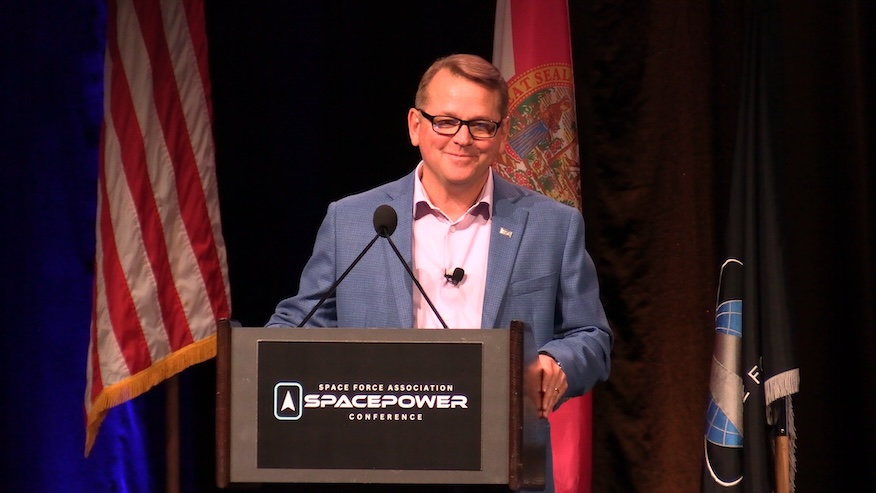
Matthew Anderson, the chief growth officer for the Space Force Association (SFA), an independent nonprofit with the mission of “advocating for and supporting the U.S. Space Force,” was nominated on Tuesday by President Donald Trump for the NASA Deputy Administrator position.
In addition to his duties with the SFA, Anderson also works as the vice president and U.S. Space Force and Air Force client executive for CACI International Inc., an IT services and consulting firm with numerous government contracts across both the Department of Defense and other federal agencies.
“As a retired United States Air Force colonel and executive of the Space Force Association, Matt Anderson brings extensive knowledge of space operations, aeronautics expertise, and industry experience,” Acting NASA Administrator Janet Petro said in a statement. “If confirmed, he would join NASA’s leadership team at a time when partnerships and a sharpened focus on mission are essential to our continued success.
“Along with President Trump’s nominee to lead NASA, Jared Isaacman, he will strengthen collaboration across sectors and help NASA advance exploration, serve the American people, and deliver results for the benefit of all.”
If confirmed, Anderson would be the second consecutive veteran chosen for the role of deputy administrator. Pam Melroy, who held the position from June 2021 through the duration of President Joe Biden’s term, was a former astronaut and retired U.S. Air Force officer.
During his first term Trump nominated James Morhard who was serving as the deputy Sergeant at Arms for the U.S. Senate at the time. He was confirmed in October 2018 and served in the role until the end of Trump’s first stint in office.
Well acquainted
Anderson and Isaacman are also well acquainted. During the first two Spacepower Conferences hosted by SFA in December of 2023 and 2024, Anderson hosted panel sessions featuring Isaacman.
The first time in 2023, Isaacman was joined by Scott ‘Kidd’ Poteet, Isaacman’s crew mate from the Polaris Dawn mission, and Maj. Gen. Stephen Purdy, the acting acquisition executive for the Space Force, and the Polaris Dawn mission was still ahead of them.

The second time in 2024, it was just a week after Isaacman had been nominated by Trump to become the NASA administrator. Anderson presented Isaacman with the inaugural Advancing Human Presence in the Space Domain Award.
“Personally, I think Jared epitomizes the Weapon Officer motto of being humble, approachable and credible,” Anderson said in December 2024.
Isaacman’s nomination was voted favorably by the Senate Committee on Commerce, Science and Transportation earlier this month and is still awaiting a date for a full Senate vote. It’s unclear when Anderson will come before the committee for his confirmation hearing.
Humble, approachable & credible…well done, @rookisaacman!
https://t.co/PSo5f422Eg
— Matt Anderson (@MattAadastra) April 10, 2025
Vast to complete Haven-1 primary structure in July 2025, ahead of target May 2026 launch date 7.5.2025 16:39
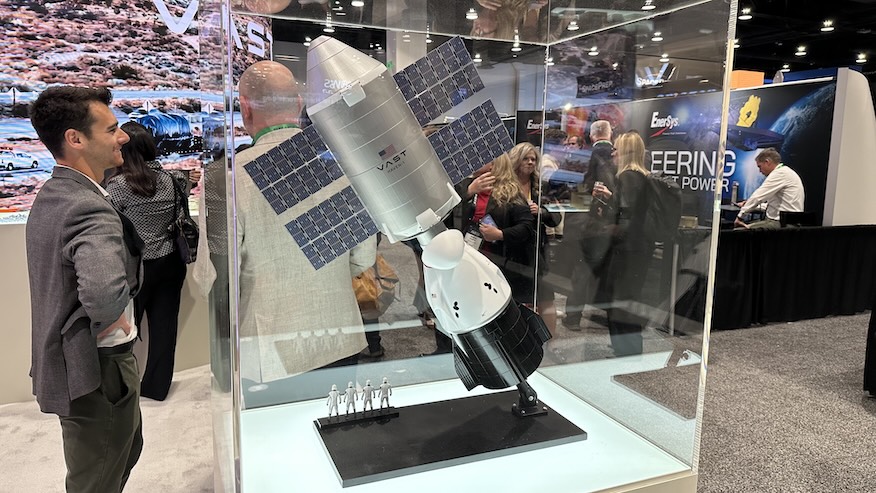
Space habitation company, Vast, is now one year away from being able to stake its claim as the first commercial space station in history.
The company based in Long Beach, California, aims to launch its single-module Haven-1 space station on a SpaceX Falcon 9 rocket in May 2026. To that end, it completed both its primary structure and qualification article and is moving into manufacturing the flight version.
“We’ve locked the design, we’ve released those drawings to our manufacturing CNC shop and we are welding it with a view to start integration and complete the flight primary structure by the end of July,” said Vast CEO Max Haot. “So, a lot more visible progress. We are just finishing out control room now. The team is there, everybody’s focused and locked in on it and we’re getting it done.”
Speaking with Spaceflight Now at the 40th Space Symposium in Colorado in April, Haot said the Vast team encompasses about 800 people at facilities across the United States. The company plans to grow by about 50 people each month and will have a roughly 1,000-person workforce in place by the time they’re ready to fly.
“It feels great. It feels easier every day than it was when we had less people, less facilities and, maybe more time, but still a lot to do,” Haot said.
Vast announced Haven-1 back in 2023 as it works to design and manufacture a space station capable of succeeding the International Space Station. NASA signed five-year, unfunded Space Act Agreement (SAA) with Vast on June 13, 2023, with the stated purpose of helping Vast’s “concept maturation and eventual implementation of [its] space station modules.”
“As part of the agency’s overall efforts, NASA is supporting the design and development of multiple commercial space stations through funded and unfunded agreements using a two-phase approach,” NASA said in a statement to Spaceflight Now.
“During the first phase, NASA is assisting its commercial space station partners in the completion of preliminary design review, or greater level of design maturity, on their concepts for future commercial station and service offerings. The providers are on track to meet that goal with some already beginning testing and manufacturing of key systems and elements.”
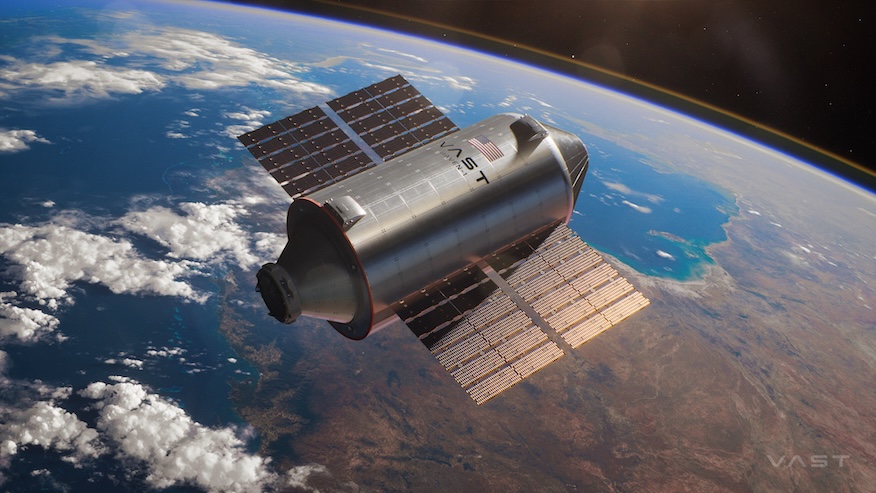
While the timing has shifted somewhat over the years since, Vast’s SAA also laid out the company’s planned 22-milestone roadmap to give NASA an overview of where it intended to go throughout the development process, ultimately leading to the Haven-2 space station, which is designed to be capable of replacing the ISS by 2028:
- May 2023 – SAA Kickoff Meeting
- June 2023 – Attitude Navigation Hardware Development Test
- July 2023 – Sub-Scale Demo Module Primary Design Review (PDR)
- Nov. 2023 – Oxygen Pressurization Demonstration
- Jan. 2024 – Large Window Pressure Test
- March 2024 – Air Revitalization Characterization Test
- May 2024 – Sub-Scale Demo Module Critical Design Review (CDR)
- Nov. 2024 – Sub-Scale Solar Array Deployment Test
- Jan. 2025 – Sub-Scale Demo Module Test Readiness Review (TRR)
- Feb. 2025 – Hardware-in-the-Loop Mission Simulation
- Aug. 2025 – Sub-Scale Demo Module Delivery to Launch Site
- Oct. 2025 – Full-Scale Demo Module Preliminary Design Review
- Dec. 2025 – Sub-Scale Module Launch
- March 2026 – Sub-Scale Demo Module Crew Mission
- July 2026 – Sub-Scale Demo Module Spin Test 1
- Oct. 2026 – Sub-Scale Demo Module Spin Test 2
- Jan. 2027 – Full-Scale Demo Module Critical Design Review (CDR)
- April 2027 – Full-Scale Solar Array Deployment Test
- July 2027 – Full-Scale Launch Separation System Test
- Oct. 2027 – Full-Scale Pressure Hull Proof Test
- March 2028 – Full-Scale Demo Module Test Readiness Review
- April 2028 – Full-Scale Hardware-in-the-Loop Mission Simulation
Back in February, Vast announced the completion of the Haven-1 primary structure qualification testing out at their facilities in Mojave, California. Through the experience of getting up to and through that testing, they made the determination that a launch in August 2025 wasn’t feasible and shifted the planned launch date to no earlier than May 2026.
A Vast spokesperson confirmed on April 28, 2025, that both the Oxygen Pressurization Demonstration and Large Window Pressure Test milestones were successfully completed and said others, like the Air Revitalization Characterization Test, are also in the books.
“We’re progressing on track aligned with our scheduled launch of Haven-1 in May 2026. We will complete the manufacturing and testing of the flight primary structure in July 2025 and later in the summer, we’ll launch Haven Demo, an in-orbit testbed for critical space station technologies and qualified hardware and software,” the Vast spokesperson said.
“From July-December 2025, we’ll complete the vehicle integration and checkout, including subsystem manufacturing and testing. Then the environmental test campaign (acoustics, vibration, EMI, TVAC) will take place at NASA’s Glenn Research Center at the Neil Armstrong Test Facility from January-March 2026 before the final step of pre-launch operations and planning.”
EMI is shorthand for EMI/EMC or Electromagnetic Interference/Electromagnetic Compatibility testing, which helps ensure the reliability of electronic systems within a spacecraft. TVAC is an abbreviation for thermal vacuum testing, which involves exposing a spacecraft to a simulated space environment in a controlled chamber.
In a statement to Spaceflight Now, NASA also clarified its role in the agreement, stating that it’s “providing support on request” and using “minimal government resources” to do so, similar to the other SAA recipients.
The agency also said that the 22 milestones laid out by Vast in 2023 are more like guidelines than hard and fast rules. Also, since no money was exchanged for this agreement, NASA said, “Milestones are unfunded and there is no requirement for completion.”
“While the milestones are intended to provide a measure of progress, they are not a partner responsibility under the agreement,” NASA said.
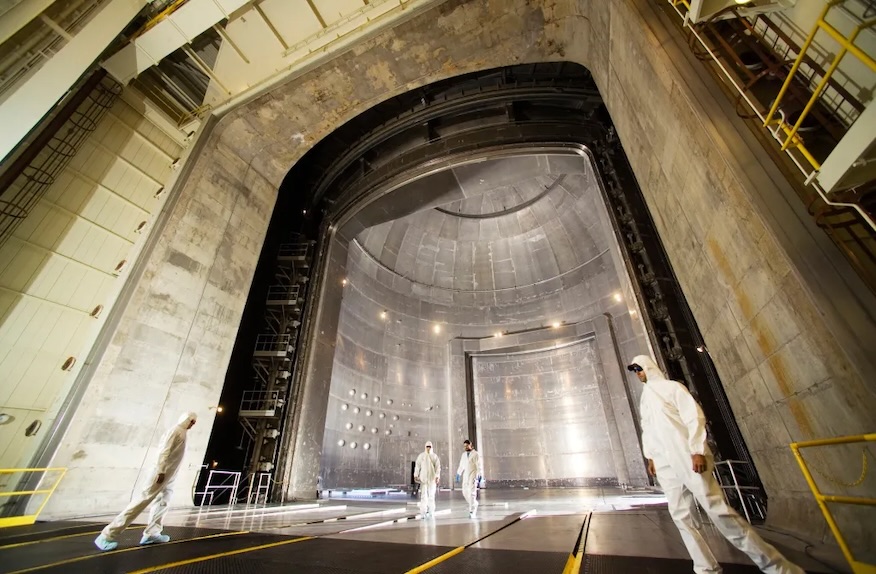
Haot said before the Haven-1 environmental test campaign begins, Vast will continue testing each piece and sub-assembly of their space station at their own facilities. But once the vehicle is fully integrated and is a single, 14-ton structure, he said they really needed NASA on board for the next phase, which centers on the vibration test and a thermal vacuum test.
For that work, they were able to reach a contract agreement with NASA to send the Haven-1 flight article to NASA’s Glenn Research Center at the Neil Armstrong Test Facility in Sandusky, Ohio. That test campaign will begin in early 2026.
“There’s basically no other facility in the world that could test such a big object as Haven-1. So firstly, it’s a relief that we have the slot. We booked it, we signed a contract because there’s not any other place we can do it,” Haot said. “And also, the contract was actually sponsored, in some ways, supported by NASA, so that we actually have priority over other programs.”
The next big announcement from Vast will be naming the crew who will be the first to fly onboard Haven-1. Haot said to expect that news “at some point soon.”
“Our goal is to secure it with mostly space agencies, international space agencies because Haven-1 is designed to be a proof point for NASA that we can work with them. So, that’s our ideal customer,” Haot said. “We are in negotiations with multiple international space agencies and I can’t wait to eventually reveal who the crew is.”
Haot said they are also getting interest from private individuals, but stressed that those who come on board need to be science focused, not tourists.
“None of the people that we talk to want to be tourists. They want to work with the payloads in the Haven-1 lab facility we have,” Haot said.
Form meets function
The Haven-1 spacecraft has a 45-meter-cubed volume and is designed to support up to four crew members for missions of an average of two-weeks in length.
It consists of four crew quarters for sleeping, several mid-deck lockers for science modules, a common area with a deployable table and multiple crew interfaces.
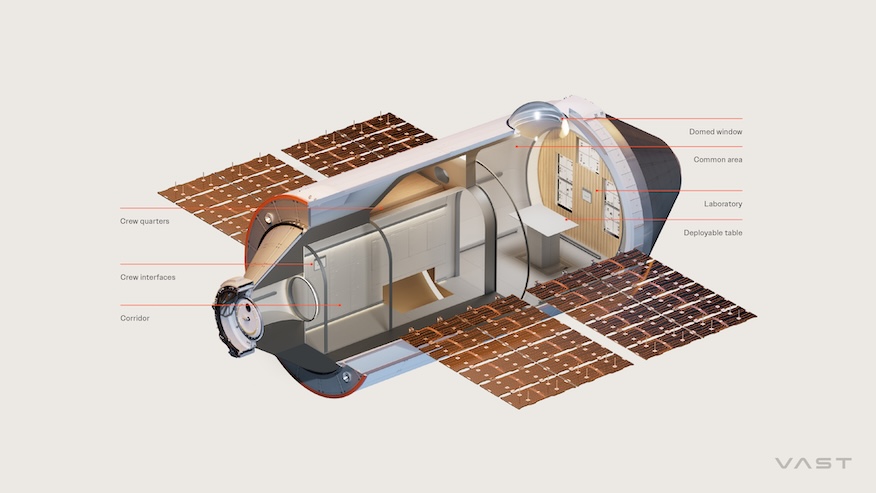
Those who see it may conjure up memories of an Apple Store and there’s a good reason for that. The combination of replica wood panels and a creamy-white color scheme come, in part, from the mind of Peter Russell-Clarke, a former Apple designer who helped influence the layout of the tech giant’s headquarters, stores and the design of products like the Apple Watch, iPhones and Mac computers.
“We’re not building a luxury destination. We’re building a laboratory in space, but it should feel good. It should great to sleep in it. You should feel rested. It should be easy to communicate,” Haot said. “That means creating an environment that is comfortable to the human, to enhance the key mission objective.”
Andrew Feustel, Vast’s Lead Astronaut who goes by Drew, told Spaceflight Now that the idea was to bring a sense of Earth onto the Haven-1 in order to make it as comfortable as possible. He said when crafting the wood-like walls, they began with maple wood slats and then moved to a veneer finish on a honeycomb background.
“The idea is that you create natural surfaces to give you that connection back to Earth,” Feustel said. “One of the things that many astronauts talk about is that separation of having six people or eight people or one person in space separated from the seven billion people down on the planet and that does create a psychological separation from Earth.
“So, having a spacecraft that reconnects you makes it easier to psychologically stay connected to the people you know and love and everything you know about life, which is down there on that planet.”
Haven-1’s domed window will enable the crew to observe and photograph the Earth and space. This test fixture is critical to confirming the window’s strength and ensuring crew safety in space. Each test kick simulates hundreds of pounds of force, mimicking accidental bumps from… pic.twitter.com/DpLV17EwhT
— Vast (@vast) April 25, 2025
Crew members will also be able to look down on the planet Earth through the 1.1 m (3.6 ft) domed window. Vast recently published a video of the window undergoing strength testing. Each so-called “kick test” simulated “hundreds of pounds of force, mimicking accidental bumps from astronauts inside the station.
“It’s really important to have a window as big as we could make it,” Feustel said. “It’s gone through a few iterations, but we’ve sort of landed on this design and this size and we think it’s really effective for doing just that: having those views of Earth that are really important and being able to take a few photos as well.”
Bringing along partners
Vast is jockeying to become the successor to the International Space Station along with other competitors. To that end, it hopes to cement its place in the history of low Earth orbit by becoming the first, commercial space station with the launch of Haven-1.
If all goes well, Vast aims to not only have its first station in orbit by next May, but also to welcome a four-person crew no earlier than late June 2026. Part of making that a reality is a partnership between the company and SpaceX.
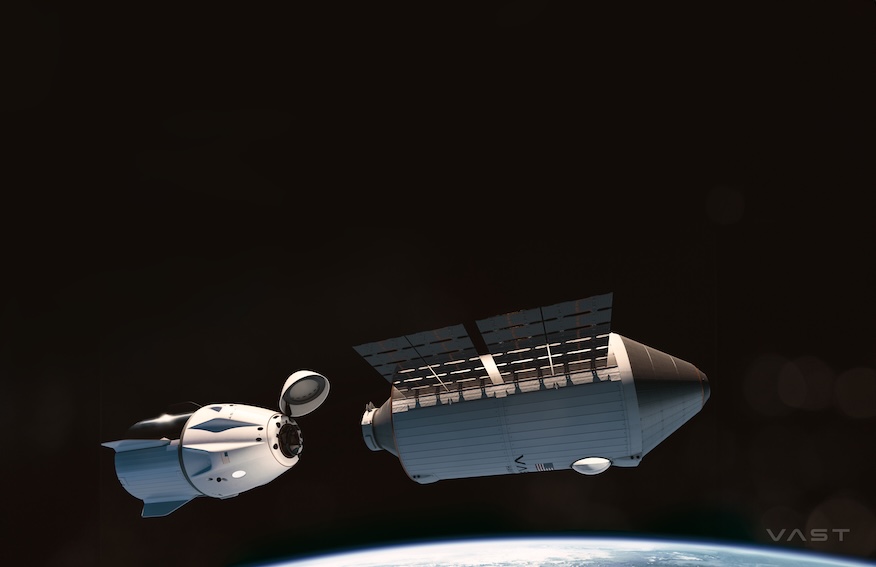
The connection between the two companies has been long established. SpaceX alumni make up seven members of Vast’s leadership team and nine members of its engineering leadership. Four out of seven members of Vast’s group of advisors also have past experience at SpaceX.
Haot said when Vast began pursuing the Haven-1 program in 2023, creating a formal relationship with SpaceX was high on their to-do list.
“The first thing we did is we went to SpaceX. We don’t believe that you should design a space station without the visiting vehicle, in this case Dragon, working with us very collaboratively,” Haot said. “It’s actually an integrated system, from a thermal point of view, from a life support point of view, they have to dock together, we have to keep the attitude. There’s a lot of engineering detail and complexity.
“You don’t want to design your space station and then six months before you launch it, call the Dragon team to make sure they’re ok.”
Part of that synergy was having SpaceX sell its docking adapter to Vast and to also conduct their own testing on Dragon at SpaceX’s facilities, also in Hawthorne, California. Haot said soon SpaceX will send Vast the flight-ready, passive docking adaptor, which will be integrated onto the flight article Haven-1.
“They are the experts, right? They are doing it (docking) to the ISS. They know, obviously, the standard. They have built the technology to do it. It’s called ‘Dragon Eye,’” Haot said. “And they basically looked at Haven-1 and they said, ‘Hey, can you keep the attitude, you know, the pointing to this tolerance?’ We said, ‘We can.’”
To support the docking process, SpaceX will add reflectors to Haven-1 in addition to the docking adapter.
Beyond its work with SpaceX, Vast is also aligning itself with several entities that have experience with the International Space Station. It first announced partnerships with Florida—based Redwire Space and European company, Yuri, back in August 2024.
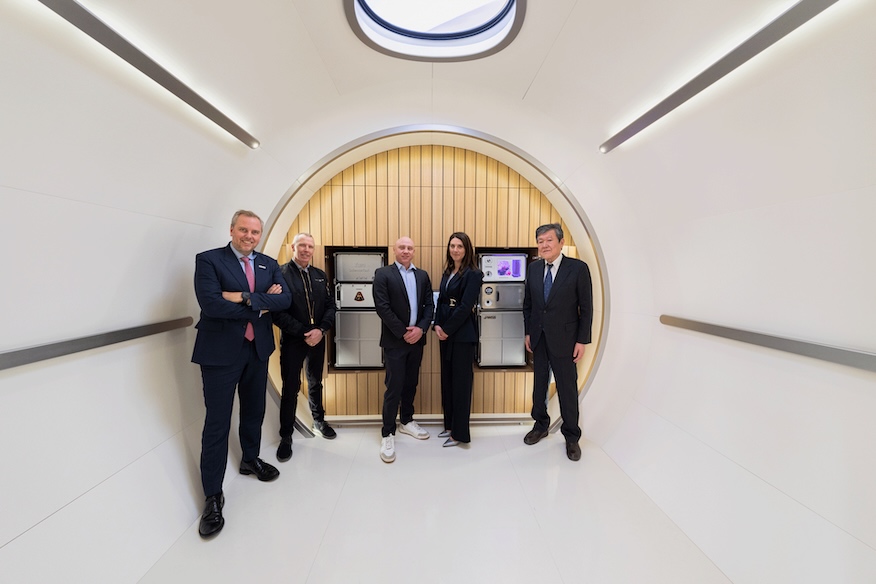
Redwire is contributing its Advanced Space Equipment Processor 4 (ADSETP4), which can host up to four pharmaceutical processing cassettes called Pharmaceutical In-space Laboratory – Bio-crystal Optimization Xperiments (PIL-BOXs). Meanwhile, Yuri is adding its ScienceTaxi incubator with a centrifuge, which allows for adjustments under different gravity conditions for up to 38 experiment units called “ScienceShells.”
During the 40th Space Symposium in early April, Vast announced three more customers, JAMSS, Interstellar Lab and Exobiosphere, which will occupy three more of the 10 total mid-deck lockers, leaving five more remaining that don’t have announced occupants.
Haot said they sought customers who are involved with “important research and science” that they believe will be “good for Vast and good for the customers that will be flying on Vast.”
“It’s also the credibility of the company. Our strategy is to work with as many people that have existing heritage on the ISS,” Haot said. “And then, it’s a negotiation and agreeing to the pricing and so on.”
Vast has also agreements for the next stage in the Haven program, Haven-2. It signed an agreement with The Exploration Company to use its reusable Nyx space capsule for cargo missions and a memorandum of understanding with the European Space Agency (ESA) to explore future crew and cargo operations onboard the Haven-2.
Haven-2 in work
The effort being put into Haven-1, and the uncrewed Haven Demo satellite before it, are designed to pave the way for the Haven-2 space station. The modules of that future station will be nearly five-meters longer than that of Haven-1 and feature two windows and two docking ports.
While the Haven-1 is able to be launched on a SpaceX Falcon 9 rocket, the Haven-2 modules will require a Falcon Heavy using an extended payload fairing. The Haven-2 will also be capable of receiving cargo missions and the ability to host 720 days worth of on-board crew consumables, compared to 160 days with Haven-1.
The plan is to launch the first of the Haven-2 modules in 2028 and continue launching the next three modules at a rate of about one every six months. Following the launch of the Haven Core module in 2030, the final version of the Haven-2 space station would be deployed on orbit by 2032.
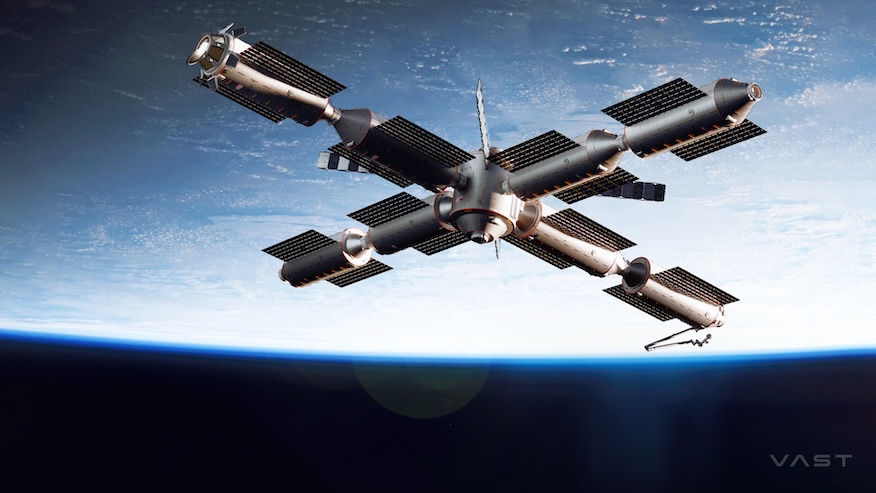
That 2032 version of Haven-2 would have a crew volume of 510 cubic meters. On its website, Vast shows opens for several roles connected to Haven-2, including one labeled “Mission Manager, Crew.”
That person would be designated to “Manage entire crew mission including onboarding, training, launch, on-orbit experience to low earth orbital destinations, being personally responsible for end-to-end mission success (contract award through return and rehabilitation).” That individual would also need to “Act as the technical subject matter expert for crewmember accommodations throughout a mission to Haven-1.”
NASA expects to issue a Draft Request for Proposal (RFP) by the end of the third quarter of fiscal year 2025 (Q3 FY25) and a final RFP by the end of Q4 FY25.
SpaceX launch 28 Starlink satellites on 470th Falcon 9 rocket launch 6.5.2025 00:30
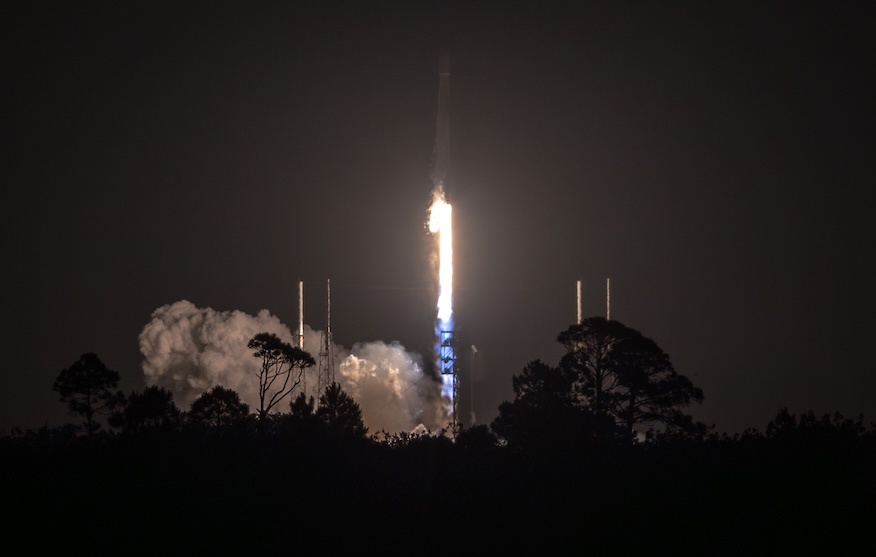
Update May 6, 9:51 p.m. EDT: SpaceX landed its first stage booster on the droneship, ‘Just Read the Instructions.’
SpaceX launched its latest batch of Starlink V2 Mini satellites to low Earth orbit on Tuesday night.
The Starlink 6-93 mission was the company’s 470th Falcon 9 rocket launch to date and added another 28 satellites to the constellation of more than 7,300 currently on orbit. Liftoff from Space Launch Complex 40 (SLC-40) at Cape Canaveral Space Force Station happened at 9:17 p.m. EDT (0117 UTC).
On Monday, the 45th Weather Squadron forecast a 85 percent chance for favorable weather during the four-hour launch window. Concerns revolved around the potential impacts from anvil and cumulus clouds, but they weren’t impactful enough to stymie liftoff.
SpaceX used the Falcon 9 first stage booster, tail number 1085, which made its seventh trip to space and back. It previously launched NASA’s Crew-9, Fram2, Firefly Aerospace’s Blue Ghost Mission 1 and GPS 3 Space Vehicle 07.
A little more than eight minutes after liftoff, B1085 landed on the droneship, ‘Just Read the Instructions’ (JRTI). It marked the 119th booster landing for JRTI and the 442nd booster landing to date.
SpaceX launches largest batch of Starlink V2 Mini satellites to date 3.5.2025 13:44
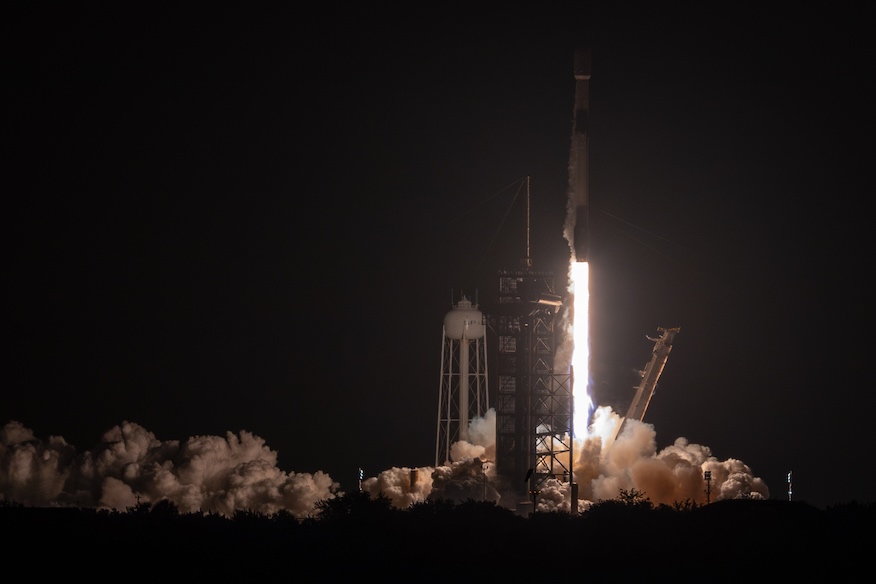
Update May 4, 5:15 a.m. EDT: SpaceX landed its first stage booster on its droneship.
SpaceX launched its largest batch of Starlink V2 Mini satellites to date in a predawn Falcon 9 flight on Sunday.
Onboard the Starlink 6-84 mission are 29 of what the company calls Starlink V2 Mini Optimized satellites, which were first publicly mentioned in the company’s 2024 Progress Report. These satellites are about 225 kg lighter than the previous versions of the Starlink V2 Mini.
Liftoff from Launch Complex 39A (LC-39A) at NASA’s Kennedy Space Center happened Sunday, May 4, at 4:54 a.m. EDT (0854 UTC). The rocket flew in a south-easterly trajectory once it left the pad.
On Friday, the 45th Weather Squadron forecast a 55 percent chance for favorable weather during the launch window. Meteorologists expressed concern with anvil clouds, cumulus clouds and generally thick clouds.
“On Saturday, southerly flow will significantly increase moisture over the Florida peninsula out ahead of the approaching front,” launch weather officers wrote. “Although the boundary will not reach the area until well after the launch window, westerly winds aloft will likely bring in mid to upper-level clouds that develop along the front.”
SpaceX used the Falcon 9 first stage booster, tail number 1078, to launch the Starlink 6-84 mission. It previously launched NASA’s Crew-6, USSF-124, Bluebird 1-5 and 15 other batches of Starlink satellites.
A little more than eight minutes after liftoff, B1078 landed on the SpaceX droneship, ‘A Shortfall of Gravitas,’ marking the 107th landing on that droneship and the 441st booster landing to date.
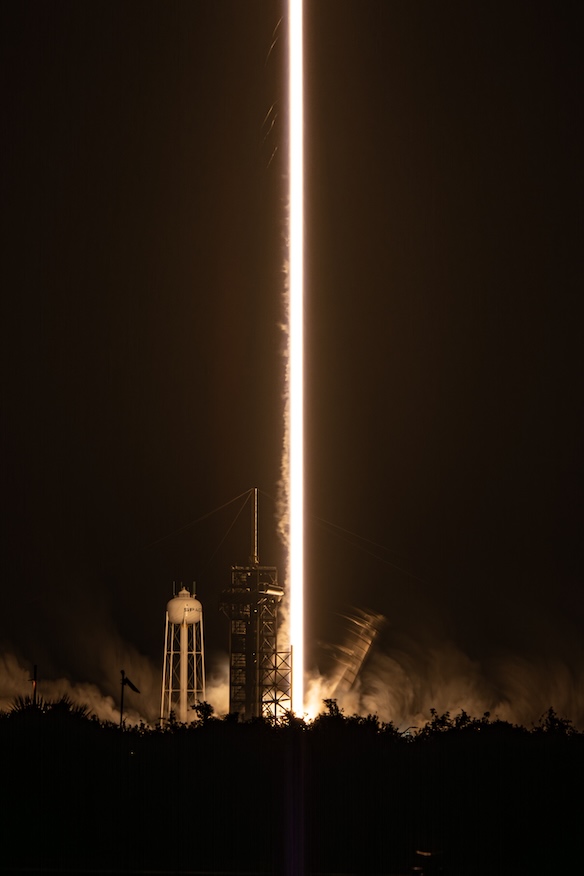
SpaceX puts Vandenberg launch on hold 3.5.2025 12:40

Update May 3, 9 p.m. EDT: SpaceX has put this launch on hold and no new launch date has been announced
Original story:
SpaceX is preparing for its third Falcon 9 launch of the month, which will send 26 Starlink V2 Mini satellites into low Earth orbit. SpaceX decided to forgo its launch opportunity on Saturday, but didn’t announce a reason for the scrub.
The Starlink 15-3 mission will fly a south-easterly trajectory when it takes off from Space Launch Complex 4 East (SLC-4E) at Vandenberg Space Force Base. Liftoff is targeting Sunday, May 4, at 10:59 a.m. PDT (1:59 p.m. EDT, 1759 UTC).
SpaceX will use the Falcon 9 first stage booster, tail number 1081, to launch this mission. It will launch for a 14th time after previously flying Crew-7, CRS-29, two Transporter rideshare missions and NASA’s PACE spacecraft.
A little more than eight minutes after liftoff, B1081 will target a landing on the SpaceX droneship, ‘Of Course I Still Love You.’ If successful, this will be the 128th booster landing on that vessel and the 441st booster landing to date.
Those on in the Southwest part of the United States will likely see far more Falcon 9 rocket launches this year compared to years past. In March, the Federal Aviation Administration (FAA) accepted the Final Environmental Assessment (EA) from the Department of the Air Force to allow SpaceX to increase the number of launches from SLC-4E from 36 up to 50.
Proposed 24 percent cut to NASA budget eliminates key Artemis architecture, climate research 3.5.2025 12:10
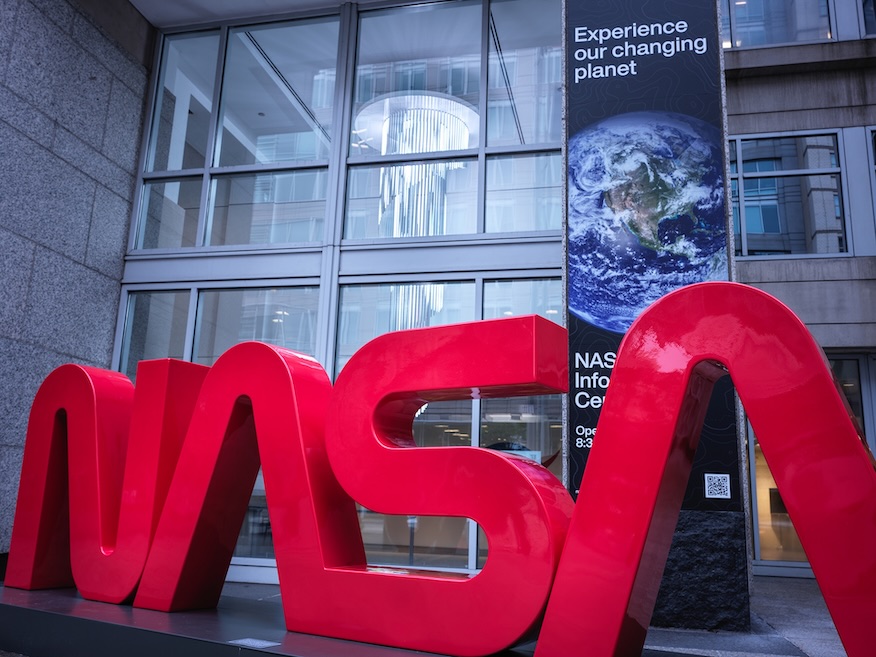
Update May 3, 5:22 p.m. EDT: Corrected the location of Northrop Grumman’s facility housing the HALO module for the Gateway.
The White House released its proposed federal spending budget for Fiscal Year 2026 on Friday and with it a series of deep cuts to most areas of discretionary spending, including to NASA. The requested cuts come, ironically, on National Space Day.
If adopted as proposed, America’s space agency is facing a 24.3 percent funding cut, dropping it from about $24.8 billion in FY25 to $18.8 billion in FY26. The agency was hoping for a funding increase to get a number of programs back on track following two years of what amounted to spending cuts due to budgets being held at FY24 spending levels.
That loss in spending will be felt most deeply by the space and Earth science divisions, which would see a loss of $2.3 and $1.2 billion respectively. Conversely, Human Space Exploration would be allocated “over $7 billion for lunar exploration and introducing $1 billion in new investments for Mars-focused programs,” which the White House believes will ensure “that America’s human space exploration efforts remain unparalleled, innovative, and efficient.”
“This proposal includes investments to simultaneously pursue exploration of the Moon and Mars while still prioritizing critical science and technology research,” said acting NASA Administrator Janet Petro in a statement. “I appreciate the President’s continued support for NASA’s mission and look forward to working closely with the administration and Congress to ensure we continue making progress toward achieving the impossible.”
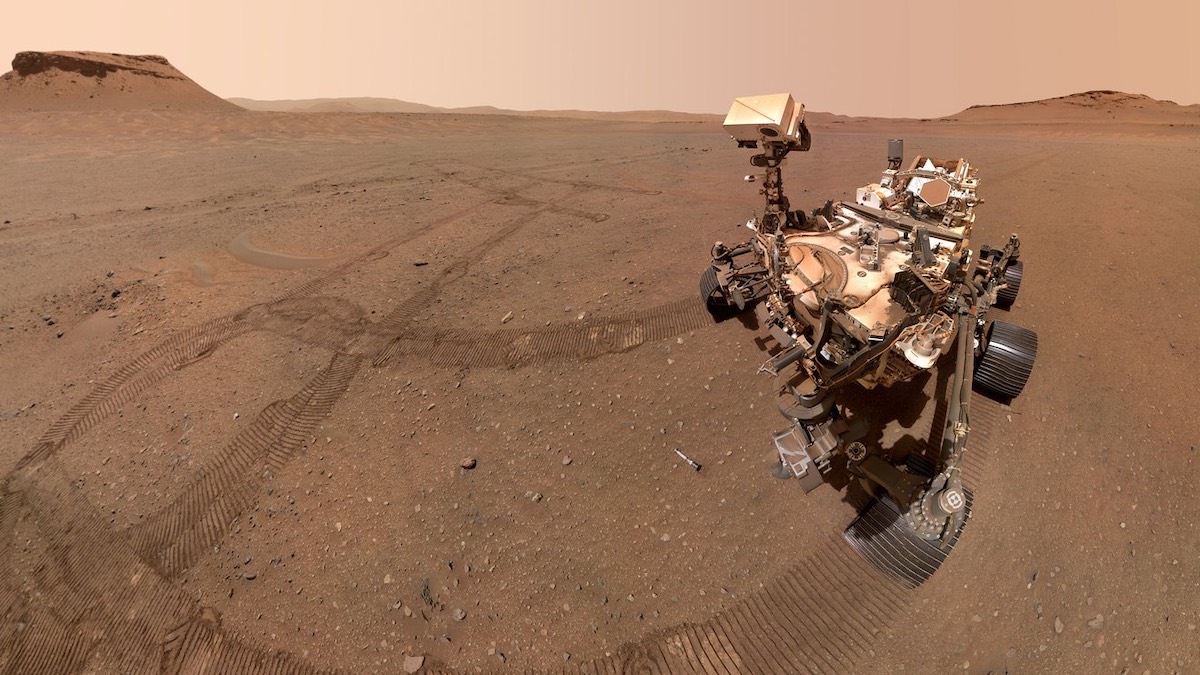
On the chopping block for President Donald Trump is the Mars Sample Return mission, which the White House said is “grossly over budget and whose goals would be achieved by human missions to Mars.”
The Trump Administration also aims to “eliminate funding for low-priority climate monitoring satellites” months after NASA scientists determined that 2024 was the warmest year on record, increasing about 2.65 degrees Fahrenheit (1.47 degrees Celsius) compared to the mid-19th century average.
“Once again, the temperature record has been shattered — 2024 was the hottest year since record keeping began in 1880,” said then NASA Administrator Bill Nelson back in January. “Between record breaking temperatures and wildfires currently threatening our centers and workforce in California, it has never been more important to understand our changing planet.”
In an April 30 letter sent to the leaders of the Senate and House committees that oversee NASA’s budget, several organizations, including the American Astronomical Society, the Coalition for Deep Space Exploration and The Planetary Society, expressed their “profound alarm” at the proposal that was being reported at the time.
“The impact extends far beyond mission hardware. These cuts would eviscerate space science research and analysis programs, crippling university departments, research institutions, and NASA centers,” the letter stated. “It would decimate the nation’s STEM talent pipeline, eliminating vital training opportunities for the next generation of scientists and engineers and likely lead to widespread layoffs within this highly skilled workforce, both in the government and industry.”
Shifting Moon priorities
Also facing the budgetary ax is the Artemis Program. The proposed budget suggests “allocating over $7 billion for lunar exploration and introducing $1 billion in new investments for Mars-focused programs,” while simultaneously calling for an early end to the Space Launch System rocket and Orion spacecraft, along with cancelling the Moon-orbiting Gateway mini-space station.
“The Budget phases out the grossly expensive and delayed Space Launch System (SLS) rocket and Orion capsule after three flights. SLS alone costs $4 billion per launch and is 140 percent over budget,” the White House said. “The Budget funds a program to replace SLS and Orion flights to the Moon with more cost-effective commercial systems that would support more ambitious subsequent lunar missions.”
Spaceflight Now reached out to both Boeing and Lockheed Martin, the prime contractors behind the SLS rocket and Orion spacecraft respectively. We’re waiting to hear back.
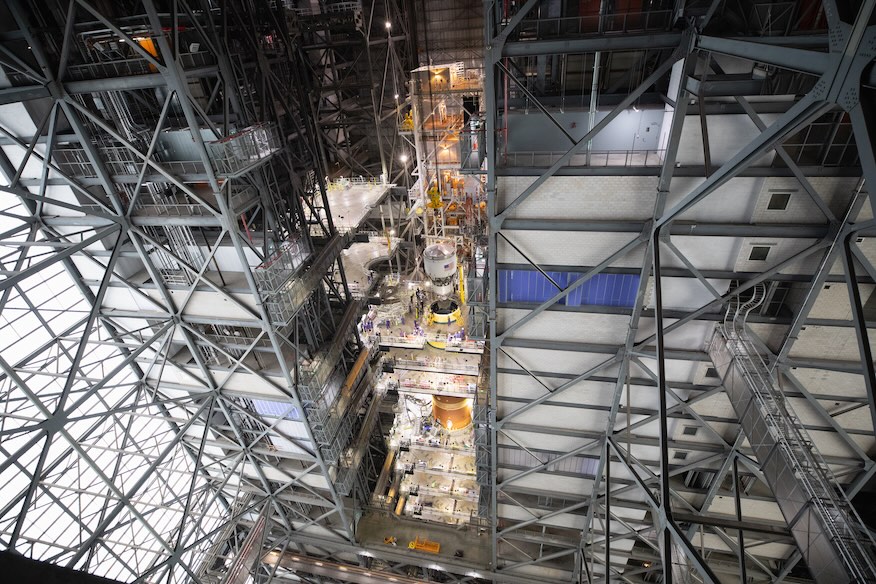
If NASA were to lose funding for SLS and Orion beyond Artemis 3, the agency would no longer need the larger SLS Block 1B rocket, which would use the 390-foot-tall Mobile Launcher 2 (ML-2) currently under construction at Kennedy Space Center.
Construction crews recently added the seventh of ten planned umbilical tower modules to the structure’s launch platform. , the prime contractor for ML-2, didn’t reply to a request for comment by publication.
“The budget would transition NASA to a more sustainable, cost-effective approach to lunar exploration by retiring the SLS (Space Launch System) rocket, Orion spacecraft, and supporting ground systems after Artemis III, and ending the Gateway program – opening the door to next-generation commercial systems and expanded international collaboration,” said NASA Press Secretary Bethany Stevens in a statement when asked about the fate of the ML-2 work, if the proposed budget were adopted.
The Trump Administration also seeks to do away with the Gateway, a lunar space station with international involvement from Canada, Europe, Japan and the United Arab Emirates. The first Gatway module was received by Northrop Grumman in Gilbert, Arizona and is set to be launched in 2027 on a SpaceX Falcon Heavy rocket.
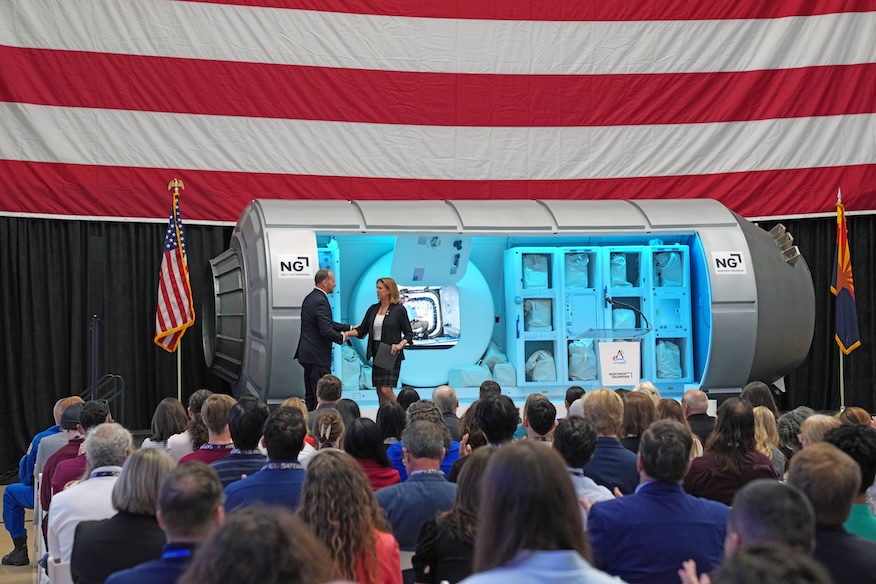
Stevens told Spaceflight Now that the agency has “informed our international partners impacted by this budget proposal” about things like the cancellation of Gateway, but said that “Those conversations will remain private as discussions are ongoing.”
The loss of Gateway would also mean changes for the agency’s Human Landing System (HLS) program, which is managed at NASA’s Marshall Space Flight Center in Huntsville, Alabama. Blue Origin’s Blue Ghost Mk. 2 lander was planned to dock with Gateway to receive astronauts before heading down to the Moon’s surface on the Artemis 5 mission.
The HLS version SpaceX’s Starship rocket will dock directly with the Orion spacecraft during Artemis 3 and is planned to dock with the Gateway during Artemis 4.
During a so-called “tag up” meeting at MSFC on Friday, Lisa Watson-Morgan, the HLS program manager, said that because of the commercial style of their program, they likely wouldn’t face much change in the work they’re doing, but acknowledged that this is still very early in the process and that more information would come in future all-hands meetings.
Audio of the meeting was shared by online publication, NASAWatch.com, which is not officially affiliated with NASA. The meeting audio was divided into two clips (Part 1 and Part 2).
“Change like this can be very, very hard. It can be very hard, even if we’re not directly experiencing it. Many of us were here for Constellation and have a lot of the battle scars from that,” Watson-Morgan said. “Sensitivity is going to be really important now, especially some of our cross-program work because frankly, we don’t really know any more than what we saw today. What I do know is we still gotta fly out Artemis 3 and that’s going to be with SLS, Orion, EGS [Exploration Ground Systems], us [HLS] and suits.
“And so, that work needs to go on and we need to be very focused on it. And so, one of the asks, as hard as it is, try to keep the mission focus.”

Space station uncertainty
The proposed cuts would also reduce spending on the International Space Station program by more than $500 million. The White House rationalizes the suggested change by stating that it helps with the transition to commercial space stations that NASA would access as a customer.
“The Budget reduces the space station’s crew size and onboard research, preparing for a safe decommissioning of the station by 2030 and replacement by commercial space stations,” the White House wrote. “Crew and cargo flights to the station would be significantly reduced. The station’s reduced research capacity would be focused on efforts critical to the Moon and Mars exploration programs.”
What a reduction in crew and cargo flights would look like is unclear. Currently NASA launches crew rotation missions that typically last about six months in duration, during which dozens of science experiments are performed onboard the orbiting outpost.
Right now SpaceX’s Dragon is the only U.S.-built spacecraft certified for astronaut missions to and from the ISS. NASA and Boeing are still working to certify the CST-100 Starliner spacecraft with plans potentially for a mission later in 2025 or early 2026.
Asked how the budget cuts would impact Starliner, Stevens said that NASA’s focus would be on “safely decommissioning the International Space Station in 2030 and transitioning to commercial replacements, focusing onboard research on efforts critical to the exploration of the Moon and Mars.”
“Beyond that, we have no additional information to offer at this time,” she said.
Congress will have its say
All of the proposals in the President’s budget request are just that: proposals. Ultimately, it will be up to the U.S. Congress to determine how it appropriates funds for FY26 and whether it will be able to pass a full budget or will instead punt with another continuing resolution.
Spaceflight Now reached out to the offices of the leaders of the Senate Committee on Commerce, Science and Technology, Sen. Ted Crez (R-TX) and Sen. Maria Cantwell (D-WA), the chairman and ranking member respectively. A spokesperson for Cantwell said Friday evening that she would not be issuing a comment at this time.
Rep. George Whitesides (CA-27), who served as the NASA Chief of Staff 2008-2010, commented on the budget request on X, calling it “the biggest attack against the agency in recent history.”
“No spin will change the fact that this would end critical missions, dramatically scale back the workforce, and risk our scientific leadership around the globe,” Whitesides said. “Not only is this the latest in an unprecedented attack on science, it will harm our ability to build the future STEM workforce in the U.S. and monitor potential climate hazards like wildfires. It is completely irresponsible, and I will fight it every way I can.”
Rep. Grace Meng (NY-06), the Ranking Member of the House Appropriations Subcommittee on Commerce, Justice, Science and Related Agencies, called the suggested cuts “shocking” in a social media post.
“They will decimate NASA’s research and education efforts and terminate funding for our nation’s dedicated scientists,” Meng wrote. “Rather than rooting out so-called ‘government waste,’ this budget puts American leadership in science, technology and innovation at risk.”
Back in mid-April, Rep. Judy Chu (CA-28), whose district includes the Jet Propulsion Laboratory and the California Institute of Technology, and Rep. Don Bacon (NE-02), who co-chairs the Congressional Planetary Science Caucus alongside Chu, issued a joint statement pushing back on the cuts. They jointly said they were “extremely alarmed” by the reports of the cuts.
“NASA Science is a cornerstone of our nation’s space program, supporting thousands of jobs nationwide and driving countless scientific discoveries and technological advancements,” the statement read. “If enacted, these proposed cuts would demolish our space economy and workforce, threaten our national security and defense capabilities, and ultimately surrender the United States’ leadership in space, science, and technological innovation to our adversaries.”
Neither Rep. Troy Nehls (TX-22), Dale Strong (AL-05) nor Rep. Mike Haridopolos who represent the districts housing the Johnson Space Center, the Marshall Space Flight Center and the Kennedy Space Center have issued a statement on the cuts.
SpaceX launches 28 Starlink satellites on Falcon 9 rocket from Cape Canaveral 1.5.2025 14:31
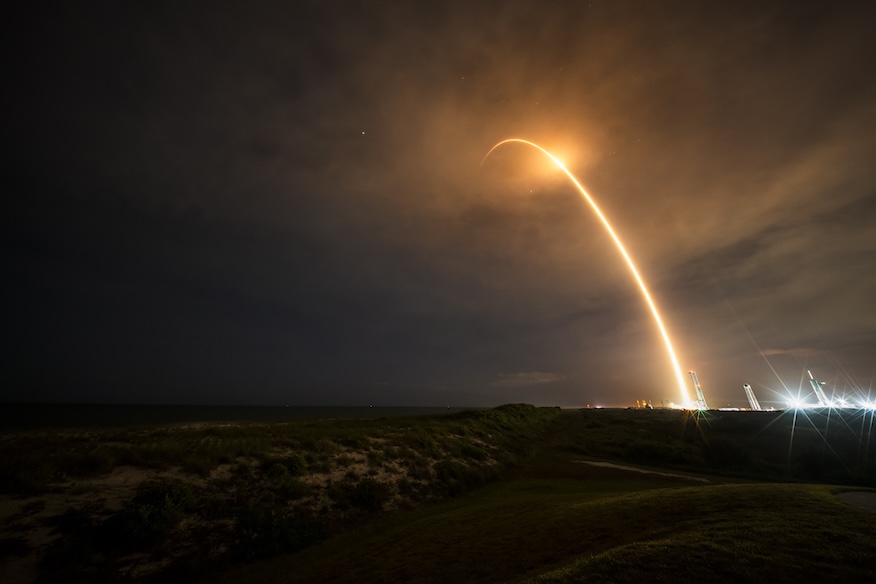
Update May 1, 11:30 p.m. EDT: SpaceX confirms successful deployment of the 28 Starlink satellites.
SpaceX kicked off of the month of May with the first of likely several Falcon 9 missions launching more of its Starlink V2 Mini satellites.
Onboard the Starlink 6-75 mission were 28 of the internet supporting satellites, adding to the more than 7,300 currently on orbit. Liftoff from Space Launch Complex 40 (SLC-40) at Cape Canaveral Space Force Station happened at 9:51 p.m. EDT (0151 UTC).
On Wednesday, the 45th Weather Squadron forecast a greater than 95 percent chance for favorable weather at liftoff with no meteorological concerns for the Falcon 9 flight.
“Strong high pressure over the western Atlantic will keep mostly dry conditions across the area through the end of the week,” launch weather officers wrote. “For launch day some widespread high cloudiness is expected, but there are no concerns for constraint violations.”
SpaceX used the Falcon booster, tail number 1080, on this mission. It conducted its 18th flight to space after supporting two private astronaut missions to the International Space Station along with two cargo missions and the European Space Agency’s (ESA) Euclid observatory.
A little more than eight minutes after liftoff, B1080 landed on the droneship, ‘Just Read the Instructions,’ marking the 118th booster landing on that vessel and the 440th booster landing to date.
The mission begins a new month of launches for SpaceX and marked its 51st Falcon 9 launch of 2025. The company notched at least a dozen launches each of the previous months of the year.
- January – 13
- February – 12
- March – 12
- April – 13
If SpaceX continues to launch 12-13 missions per month, it will close out the year with anywhere between 146 and 154 Falcon launches, below it most recently stated target of 170 orbital flights with its Falcon family of rockets.
In order to achieve its stated goal, SpaceX would need to launch at least 15 times per month or a pace of basically every two days between its three launch pads.
That will be made partially easier thanks to an easing of launch restrictions on the West Coast. Back in November 2024, the Department of the Air Force issued its Final Environmental Assessment (EA) regarding a proposal to increase the number of Falcon 9 launches from Space Launch Complex 4 East (SLC-4E) from 36 up to 50 annually. In March 2025, the Federal Aviation Administration (FAA) adopted that Final EA an issued its own Finding of No Significant Impact/Record of Decision.
Currently, the FAA is considering a Draft EA analyzing SpaceX’s proposal to increase the number of launches at SLC-40 in Florida from 50 up to 120 per year. The proposal would also allow for the construction of a booster landing zone at SLC-40 that would support up to 34 landings per year.
A virtual meeting on the SLC-40 proposal is scheduled for May 8 and the public comment period will close on May 15. Click here for information regarding registration for that virtual meeting.
U.S. Senate Commerce Committee advances Isaacman’s nomination for NASA administrator to full Senate 30.4.2025 19:17
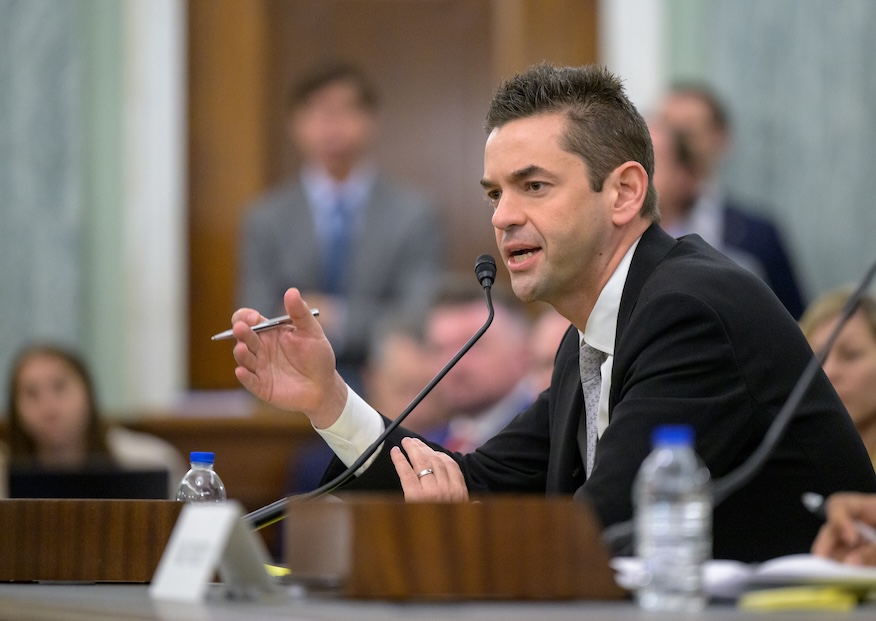
President Donald Trump’s pick to lead NASA in his second term is one step closer to becoming the agency’s 15th administrator.
On Wednesday, by a vote of 19-9, the U.S. Senate Commerce Committee chose to advance the nomination of Jared Isaacman to the full Senate. That vote will come at a later date, which has not yet been scheduled.
Committee Chairman Sen. Ted Cruz (R-TX) opened the hearing by voicing his intent to support Isaacman’s nomination to move out of committee, urging him to keep the agency focused on crewed lunar exploration.
“As we heard at his nominating hearing earlier this month, quote ‘NASA was built to do the near impossible.’ I agree, but NASA’s plans for space must remain grounded in reality and align with our strategic interests,” Cruz said. “Existing law directs NASA to establish a, quote, ‘sustained human presence in cislunar space or on the Moon.’ Federal law explicitly calls the Moon, quote, ‘a stepping stone’ to reaching Mars.
“In other words, our path to predominance in space, begins with the Artemis missions.”
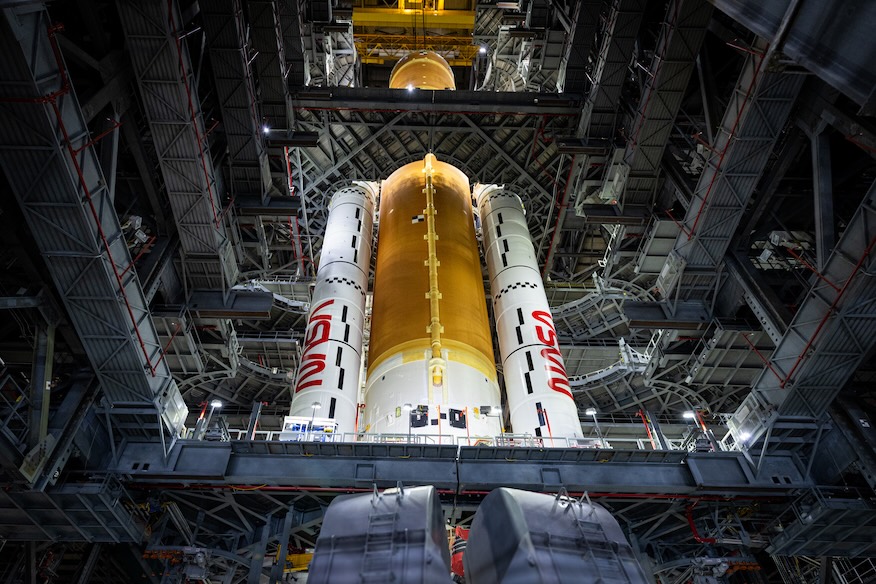
During his confirmation hearing earlier this month, Isaacman faced a number of questions regarding his support of the current Artemis program architecture, using NASA’s Space Launch System rocket and Orion spacecraft as the method that the agency’s astronauts will use to get to and from cislunar space.
Following his verbal response, Isaacman also answered a series of written questions to Democrats and Republicans as well. In his list of questions, Cruz asked about Isaacman’s long-term vision for transporting crew to and from the Moon and eventually Mars.
Isaacman said that the use of NASA’s rocket isn’t the best solution in the future.
“As I stated during the hearing, SLS is the current plan and the fastest way to send American astronauts back to the Moon ahead of our geopolitical rivals. And this is a race we can’t risk losing,” Isaacman wrote. “But once our initial lunar objectives have been met, I believe NASA should transition from competing with industry and focus again on what no other agency or organization is capable of accomplishing.”
Isaacman didn’t specify what constituted NASA’s “initial lunar objectives,” but went on to state his support for the commercial launch market’s ability to provide heavy-lift capabilities.
“NASA should take advantage of that competition and eventually refocus its world-class talent and infrastructure on what no one else is doing: developing the next generation of exploration technologies,” he wrote. “That includes nuclear-powered spacecraft, which I believe represent the logical next step for long-duration, deep space missions beyond Mars.”
Isaacman also earned the support of Ranking Member Sen. Maria Cantwell (D-WA) who also cited his support was tied to the goals of the Artemis program as “the key requirement that we have to have in this position.”
“While it’s not clear to me where the Trump Administration will ultimately end up on the NASA budget, and I have concerns about some of their proposed cuts today, Mr. Isaacman seems to be committed to the current plan for both lander redundancies, Space Launch Systems and returning to the Moon as fast as possible,” Cantwell said.
“I think this is a very big competitive issue for the United States of America. That competitiveness is not just a goal, it’s a reality that some day we may wake up and find ourselves falling behind. So today, I will support his nomination and hope that we will continue to get leadership out of the administration on clarification on supporting a robust NASA budget.”
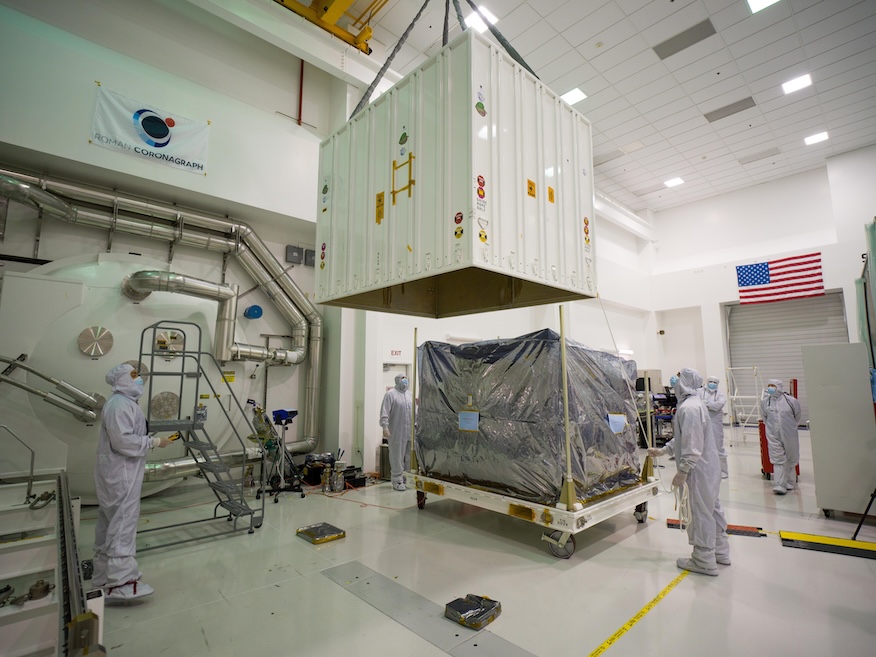
The agency is facing potentially steep cuts of 47 percent to its science program. In a recent podcast appearance, Casey Dreier, the Chief of Space Policy for The Planetary Society, a nonpartisan non-profit organization, described the cuts as generationally detrimental.
“This is not a budget that is in a sense focused on efficiency in that sense, and this is not a budget that screams good, smart management. This is a budget of destruction and retrenchment,” Dreier said. “It would fundamentally alter the United States’ relationship to space science, and it would fundamentally present a far smaller vestigial version of itself than we’re used to seeing in our lifetimes.”
In response to Cantwell’s written question about the nearly 50 percent reduction to NASA’s science budget, Isaacman said that while he hasn’t reviewed or been party to official discussions, this move “does not appear to be an optimal outcome.”
“As I stated during the hearing, NASA requires the best and brightest talent from across the nation to accomplish what no other agency or organization can—especially in environments that demand doing more with less,” Isaacman wrote. “I support the President’s commitment to eliminating fraud, waste, abuse, and unnecessary bureaucracy that can hinder the agency’s mission. If confirmed, I will advocate for NASA’s priorities and the resources needed to pursue them as efficiently and effectively as possible.”
When called for a vote, nine Democratic senators on the committee voted against advancing Isaacman’s nomination with four joining all the Republican senators in the affirmative. None of the senators who voted against advancing his nomination chose to spoke during the hearing before casting their vote.
SpaceX launches 23 Starlink satellites on 50th Falcon 9 rocket of 2025 29.4.2025 01:16
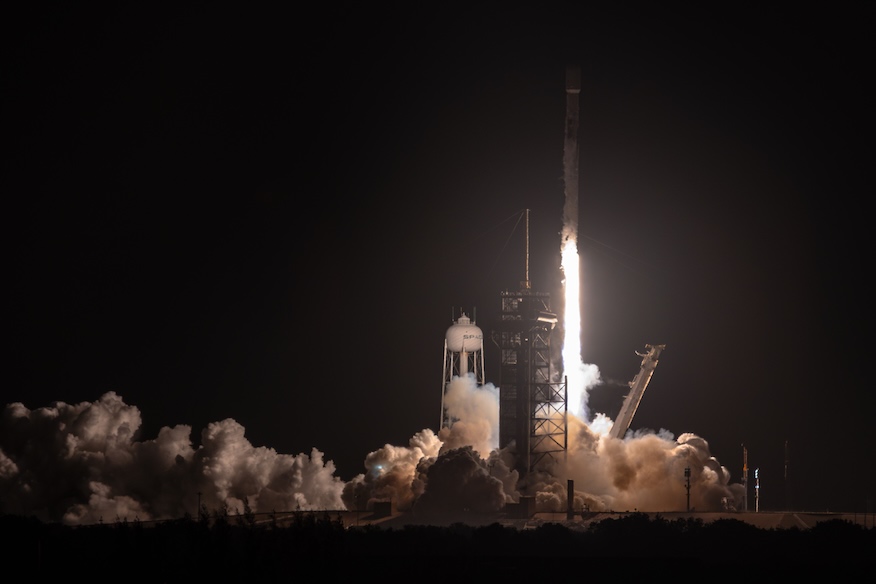
Update 11:05 p.m. EDT: SpaceX landed the first stage booster on the droneship.
SpaceX completed its second Falcon 9 rocket launch in less than half a day. The Starlink 12-10 mission took flight from NASA’s Kennedy Space Center about six hours after another Starlink flight took off from Vandenberg Space Force Base.
Liftoff from Launch Complex 39A happened at 10:34 p.m. EDT (0234 UTC). This was SpaceX’s 50th Falcon 9 launch of the year.
On Sunday, the 45th Weather Squadron forecast a 75 percent chance for favorable weather during the launch window. Meteorologists said they were tracking potential concerns with violations of the Cumulus Cloud and the Anvil Cloud Rules.
“The main weather threats for the primary launch opportunity are cumulus clouds associated with nearby showers and any lingering anvil clouds from remnant thunderstorms,” launch weather officers wrote.
SpaceX debuted a new booster for this mission. It’s believed to either bear the tail number of B1091 or B1094, but it wasn’t clear prior to launch which one was in the loop.
A little more than eight minutes after liftoff, the booster landed on the droneship, ‘A Shortfall of Gravitas.’ This marked the 106th booster landing on that droneship and the 439th booster landing to date.
ULA launches first production Amazon Kuiper satellites on Atlas 5 rocket from Cape Canaveral 28.4.2025 17:33
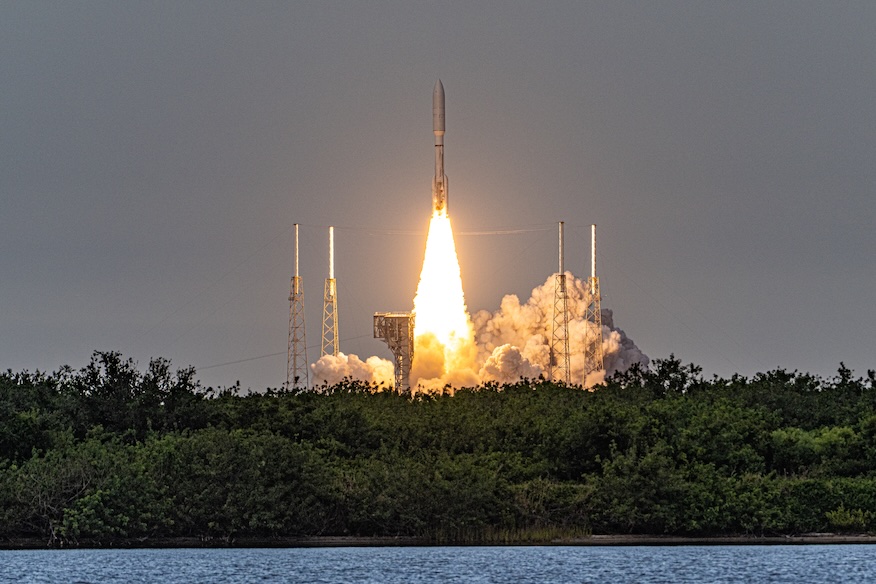
Against the setting Sun, United Launch Alliance’s Atlas 5 rocket thundered off the pad at Cape Canaveral Space Force State to begin the flight of the first production satellites for Amazon’s Project Kuiper satellite internet constellation.
Five solid rocket boosters helped propel the rocket and the 27 satellites on board from Space Launch Complex 41 (SLC-41) at 7:01 p.m. EDT (2301 UTC).
The threat of anvil clouds caused ULA to adjust the liftoff time by one minute, but otherwise, weather was quite pristine for the north-easterly trajectory. ULA used its most powerful Atlas 5 configuration, 551, which features five solid rocket boosters from Northrop Grumman.
Including this mission, Amazon has eight remaining Atlas 5 rockets that it purchased to launch its Kuiper satellites. In a media roundtable on earlier this month at the 40th Space Symposium, ULA President and CEO Tory Bruno said the company might launch another Kuiper Atlas mission in the late spring or early summer timeframe before shifting to their first national security mission on a Vulcan rocket.
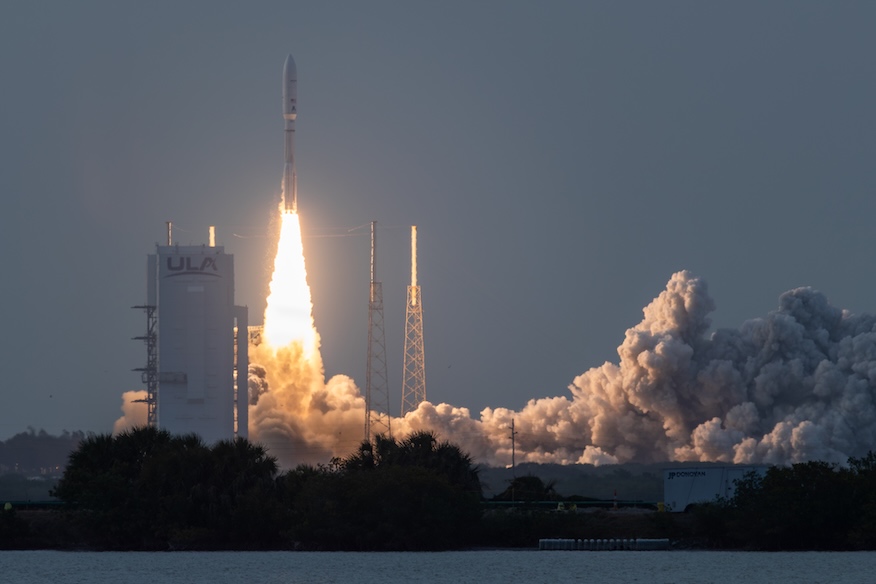
When asked if ULA expected to go through all eight of Amazon’s Atlas rocket missions this year, Bruno said, “Maybe, not necessarily. I don’t think I’ll get all of the Atlases off for them this year. I think it’ll be ’26 before we get them all done,” he said.
Bruno said they are looking at late summer for the first launch of Kuiper satellites on a Vulcan rocket, which would carry 45 Kuiper satellites on board. The next two launches of Vulcan are planned for missions from its National Security Space Launch (NSSL) Phase 2 contract. USSF-106 will launch first, followed by USSF-87.
“There will be several of each [Vulcan and Atlas] and that should take Amazon well on their way to where they have enough spacecraft for revenue generation, which really means the initial services being offered, which is pretty exciting,” Bruno said.
Bruno expects ULA will launch somewhere in the area of 11-13 or so missions before the end of the year, with there being roughly an equal split between Atlas and Vulcan flights. Those will be a mixture of launches for the U.S. government and Amazon.
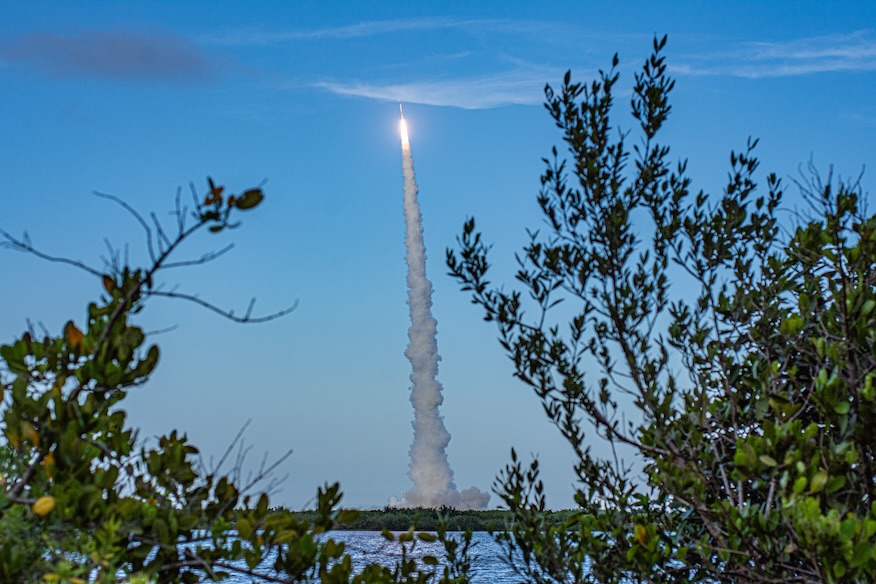
Project Kuiper emerges
The Project Kuiper constellation will eventually consist of more than 3,200 satellites in low Earth orbit. Like SpaceX’s Starlink, Amazon wants to have a large constellation to provide low latency internet for commercial customers, both civilian and governmental.
“We have set out to design the most advanced satellite network ever built and we have created the whole thing in house at Amazon,” said Rajeev Badyal, the vice president of Technology for the Kuiper Satellite Network, in an Amazon-produced video. “You need just about every technology area to contribute to build the satellite, the propulsion system, the solar arrays, the silicon, the phased array antennas, the optical inter-satellite links.”
The Kuiper 1 mission will carry the first full production satellites for Project Kuiper. Amazon launched two prototype satellites on another Atlas 5 rocket back in October 2023 to test the capabilities and give Project Kuiper better insight into some changes needed for the final version.

According to stipulations from the Federal Communications Commission (FCC), Amazon said it will begin customer service once the first 578 satellites are launched and operational.
The 3,236 satellites will be spread across 98 orbital planes at 590 km, 610 km and 630 km in altitude. For comparison, the International Space Station orbits between 370-460 km in altitude.
“It might not all go perfectly, but we have an incredible commitment to this project and an incredible team committed to this mission,” Badyal said.
Beyond the Atlas 5 rockets it purchased, Amazon also bought 38 launches on ULA’s Vulcan rocket as well as a combined 33 launches on Arianespace’s Ariane 6, Blue Origin’s New Glenn and SpaceX’s Falcon 9 rockets.
Offering a service to regular people and businesses isn’t Amazon’s only aim. The company also established Kuiper Government Solutions (KGS) LLC as a legally separate entity from Project Kuiper.
Amazon said KGS is designed “to support specialized government capabilities, from secure terrestrial broadband to in-space networking solutions using the Kuiper commercial network.”
KGS and L3Harris Technologies announced a partnership on Monday to offer a combined service for government needs. In pitching this to prospective government customers, L3Harris said that it brings “Proven, resilient open systems from SATCOM terminals to robust tactical radios (to) ensure seamless integration into your existing operations.”
“The synergies of our new partnership will deliver out-of-the-box interoperability and specialized systems for military, public safety and commercial applications, providing customers more flexibility in their communication networks than ever before,” said Sam Mehta, President, Communication Systems for L3Harris, in a statement. “This partnership is crucial for providing extended, enhanced capabilities not available today and reinforces our mutual commitment to deliver resilient, secure and trusted solutions to our customers.”


